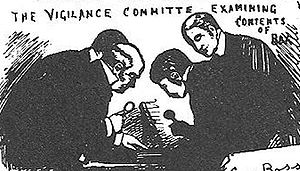
Whitechapel Vigilance Committee
Encyclopedia

London
London is the capital city of :England and the :United Kingdom, the largest metropolitan area in the United Kingdom, and the largest urban zone in the European Union by most measures. Located on the River Thames, London has been a major settlement for two millennia, its history going back to its...
's Whitechapel District
Whitechapel District (Metropolis)
Whitechapel was a local government district within the metropolitan area of London, England from 1855 to 1900. It was formed by the Metropolis Management Act 1855 and was governed by the Whitechapel District Board of Works, which consisted of elected vestrymen.Until 1889 the district was in the...
during the period of the Whitechapel murders of 1888. The volunteers patrolled mainly at night in the search for the murderer. The committee was set up by local businessmen who were concerned that the killings were affecting trade in the area. It was led by George Lusk
George Lusk
George Akin Lusk was a builder and decorator who specialised in music hall restoration, and was the Chairman of the Whitechapel Vigilance Committee during the 'Whitechapel Murders' of Jack the Ripper in 1888. Lusk was a Freemason, having been initiated into the Doric Lodge on 14 April 1882, but he...
, a local builder who was elected chairman during the committee's first meeting on 10 September 1888.
Other committee members included Mr. Joseph Aarons, the landlord of The Crown public house on Mile End Road (treasurer), Mr. B. Harris (secretary), and Messrs. Cohen, H. A. Harris, Laughton, Houghton, Lord, Isaacs, Rogers, Mitchell, Barnett, Hodgkins, Lindsay, Reeves, and Jacobs. The Daily Telegraph reported on 5 October 1888 that the leading members of the committee were "drawn principally from the trading class, and include a builder, a cigar-manufacturer, a tailor, a picture-frame maker, a licensed victualler, and 'an actor.'" The latter was probably the entertainer Charles Reeves.
As chairman of the committee, Lusk's name appeared in the national newspapers and on posters in Whitechapel appealing for information concerning the identity of Jack the Ripper and complaining about the lack of a reward for such information from the government. Due to this publicity, Lusk received threatening letters through the post, allegedly from the murderer. Lusk is also mentioned in a letter dated 17 September 1888, reportedly discovered among archive materials in the late 20th century; however, most experts dismiss this as a modern hoax.

Home Secretary
The Secretary of State for the Home Department, commonly known as the Home Secretary, is the minister in charge of the Home Office of the United Kingdom, and one of the country's four Great Offices of State...
Henry Matthews
Henry Matthews, 1st Viscount Llandaff
Henry Matthews, 1st Viscount Llandaff PC, QC was a British lawyer and Conservative politician. He is best remembered for his role in the 1885 Sir Charles Dilke divorce trial and for his tenure as Home Secretary from 1886 to 1892.-Background and education:The member of an old Herefordshire family,...
refused, the committee offered its own reward. The committee also employed two private detectives, Mr. Le Grand (or Grand) and Mr. J. H. Batchelor, to investigate the murders without the involvement of the local police.
The committee was unhappy with the level of protection that the community was receiving from the police
Metropolitan police
Metropolitan Police is a generic title for the municipal police force for a major metropolitan area, and it may be part of the official title of the force...
, so it introduced its own system of local patrols, using hand-picked unemployed men to patrol the streets of the East End every evening from midnight to between four and five the next morning. Each of these men received a small wage from the Committee, and patrolled a particular beat, being armed with a police whistle, a pair of galoshes
Galoshes
Galoshes , also known as boat shoes, dickersons, or overshoes, are a type of rubber boot that is slipped over shoes to keep them from getting muddy or wet. The word galoshes might be used interchangeably with boot, especially a rubberized boot...
and a strong stick. The committee itself met each evening at nine in the The Crown, and once the public house closed at 12.30 a.m. the committee members would inspect and join the patrols. These patrols were shortly to be joined by those of the Working Men's Vigilance Committee.
The "From Hell" letter
From Hell letter
The "From Hell" letter is a letter posted in 1888 by a person who claimed to be the serial killer known as Jack the Ripper....
, which was sent with half of a human kidney, was posted to the committee's chairman George Lusk, who received it on October 16, 1888. Many scholars of the Jack the Ripper murders regard this letter as being the communication most likely have to been sent by the killer.
External links
- http://www.casebook.org/about_the_casebook/cbindex.html?showindex=Whitechapel%20Vigilance%20CommitteeThe Whitechapel Vigilance Committee on the Casebook: Jack the RipperCasebook: Jack the RipperCasebook: Jack the Ripper is a website devoted to the historical mystery of the Jack the Ripper murders of Whitechapel and the surrounding areas of London in 1888 and possibly other years. The site was started in January 1996 and features suspect, victim and witness overviews as well as more than...
website] - The Whitechapel Vigilance Committee on the London Walks website

